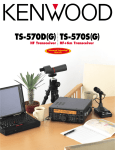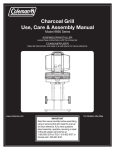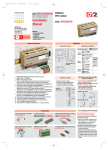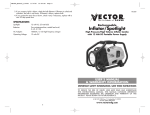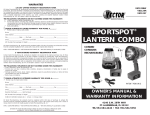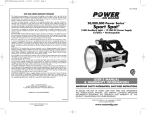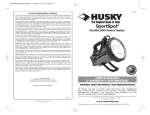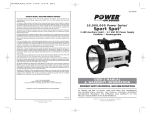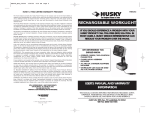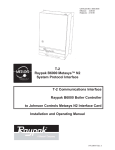Download Kenwood TH-79AKSS User's Manual
Transcript
KENWOOD SKY COMMAND SYSTEM Operation Manual KENWOOD COMMINICATIONS CORPORATION KENWOOD COMMUNICATIONS CORPORATION This operation manual is used for the KENWOOD SKY COMMAND SYSTEM (hereinafter referred to as KSS), which is compatible with the TH-79AKSS and TH-D7A, which is available for sale on a limited basis. KENWOOD SKY COMMAND SYSTEM TH-D7A: Refer to the TH-D7A Instruction manual (page 83) for instructions on how to use the KSS with the TH-D7A transceiver. Notes: PG-4R modification necessary when KSS II operation with the TH-D7A. KSS provides a wireless microphone system over a short distance. Accordingly, KSS is very useful in the following situations: • Watching for DX, schedules, or tuning the bands while working around the house. • Operating HF radio while relaxing in your living room, instead of in the shack. • Operate without carrying a wired microphone around the shack. • Operate HF while camping, picnicking, or at local sporting events (HF in the mobile). At present, KSS is capable of communication in voice mode. Please use SSB/AM/FM modes. To get the most out of this system, KSS allows HF memory channel operation, and fixed frequency operation, even if VFO is used. It is more effective if you operate by selecting HF operation frequencies and modes beforehand. KSS can control RIT, if required. In addition, KSS can operate VFO and can change the frequency in steps. Therefore, the conventional operating method of tuning the VFO is not suitable in this system. Please cut the white wire carefully (TH-D7A ONLY). TH-79AKSS:(Does not work on the other TH-79 series) KSS provides a system wherein the portable transceiver is used as a wireless remote control, microphone, and repeater used in operation with the TS-570S(G)/D(G) and/or TS-870S HF transceivers. Wireless remote control operation has been achieved through the utilization of the portable transceiver’s DTMF and CTCSS functions, and the HF transceiver’s PC control functions. This system is capable of transmitting and receiving HF radio signals, changing over from transmit to receive, setting frequencies, switching memory channels, and other functions. TABLE OF CONTENTS KSS OPERATION.................................................................................................................................................... 2 SUPPLIED EQUIPMENT......................................................................................................................................... 3 OPERATION............................................................................................................................................................ 3 Outline ............................................................................................................................................................. 3 Equipment Interface ......................................................................................................................................... 3 Setting the Mode .............................................................................................................................................. 3 CMD SYSTEM ........................................................................................................................................................ 3 Setup Procedure................................................................................................................................................ 3 Setup Cancellation ........................................................................................................................................... 3 Other Limits in CMD Mode ............................................................................................................................. 3 KSS KEYPAD FUNCTIONS.................................................................................................................................... 4 EXPLANATION OF FUNCTIONS .......................................................................................................................... 4 TRP SYSTEM .......................................................................................................................................................... 5 Setup Procedure................................................................................................................................................ 5 Setup Cancellation ........................................................................................................................................... 5 RS-232C SETUP ...................................................................................................................................................... 5 HF TRANSCEIVER SETUP..................................................................................................................................... 5 COMMON ITEMS FOR TRANSMISSION/RECEPTION ........................................................................................ 5 Confirmation of Preparation ............................................................................................................................. 5 System Initial Set Up........................................................................................................................................ 5 RECEPTION OPERATION...................................................................................................................................... 6 AF Volume Control Set Up on the HF Transceiver ........................................................................................... 6 TRANSMISSION OPERATION............................................................................................................................... 6 HF TRANSCEIVER FREQUENCY SELECTION.................................................................................................... 6 VFO Operation................................................................................................................................................. 6 Memory Channel Operation ............................................................................................................................. 6 MODE CHANGEOVER........................................................................................................................................... 7 OTHER FUNCTIONS .............................................................................................................................................. 7 RIT Function.................................................................................................................................................... 7 Voice Frequency Read-Back ............................................................................................................................. 7 BUSY Control Function ................................................................................................................................... 7 OPERATING HINTS................................................................................................................................................ 7 1 →440MHz band: Voice signal to the HF transceiver →440MHz band: Control signal to the HF transceiver • The operator controls the HF transceiver from the portable COMMANDER (CMD) TH-79AKSS. 440 MHz 144 MHz • The received HF signal is re-transmitted by the TRANSPORTER (TRP) TH-79AKSS on the 144 MHz band. • Voice is transmitted from the CMD unit on the 440 MHz band. • The control signals, for frequency and functions of the HF transceiver, are sent from the CMD unit on the 440 MHz band. COMMANDER (CMD) TH-79AKSS • With the (optional) VS-3 voice unit installed in the HF transceiver, the operator can confirm the HF frequency. HF ANT →144 MHz band: HF receive audio 440 MHz 144 MHz RS-232C MIC IN SP OUT TRANSPORTER (TRP) TH-79AKSS I /O UNIT HF TRANSCEIVER TS-570D(G)/S(G) or TS-870S TS-570D(G)/S(G) or TS-870S Note: u Carefully select a frequency in the 440 MHz band for transmission from the CMD to the TRP (according to FCC regulations). u This system uses duplex operation. u 440 MHz (UHF) voice identification. FCC Rule 97.119, Station Identification. Each amateur station, except a space station or telecommand station, must transmit its assigned call sign on its transmitting channel at the end of each communication, and at least every 10 minutes during a communication, for the purpose of clearly making the source of the transmissions from the station known to those receiving the transmissions. No station may transmit unidentified communications or signals, or transmit as the station call sign, any call sign not authorized to the station. (Rear) ƒ Ó 2.5mm (1/10”) SP ƒ Ó 3.5mm(1/8”) 2-conductor plug ƒ Ó 3.5mm (1/8”) MIC TH-79AKSS TRP MODE This ƒ Ó 2.5mm (1/10”) jack is for use only with the TH-D7A transceiver. 2 TS-570D(G)/S(G) or TS-870S (Front) ITEM I/O UNIT 2.5mm Stereo Cable n Setup Procedure QUANTITY 1) Turn the power ON for the portable transceiver being used for CMD. 1 1(use for TH-D7A only) Operation Manual 2) Set up its DTSS code and CTCSS frequency on the 440 MHz band, its operating frequency on the 144 MHz band, and its operating frequency on the 440 MHz band. (For operation of the TH-79AKSS, refer to its Operation Manual). 1 OPERATION n Outline 3) Turn off the transceiver’s power. To operate the system, follow these basic procedures. 4) Press and hold the PTT and VFO buttons, then turn on the transceiver’s power. The following display appears when the CMD mode is setup successfully. 1) Connect the two TH-79AKSSs, the I/O UNIT, and the HF transceiver (TS-570D(G)/S(G) or TS-870S). Note: 2) Place one of the TH-79AKSSs in CMD mode, and the other in TRP mode. 3) Set up your HF transceiver. 4) Start your operation. n Equipment Interface Connect the equipment as shown on page 2. Be sure to turn OFF the HF power source and the two TH-79AKSSs before beginning. u Turn OFF the following functions: transmit inhibit, DTSS, paging, bell, and ABC. u Using a high CTCSS frequency may cause an audible tone to be output from the speaker of the HF transceiver. If this happens, select a lower CTCSS frequency which does not cause the problem. n Setting the Mode Note: The security code for your KSS consists of both your DTSS code and your CTCSS frequency. n Setup Cancellation • This system is set up to operate only if the DTSS code, and CTCSS frequency is matched on the 440 MHz band, between the two portable transceivers. You must decide these two settings. The same frequencies and DTMF code MUST be used when setting up the TRP mode. 1) Turn OFF the CMD transceiver’s power. 2) Push and hold the PTT and VFO buttons, then turn ON the transceiver’s power. Cancellation is successful when “Sky” and “Cmd” no longer appear on the screen. • The received HF signal is transmitted from the TRP to the CMD on the 144 MHz band. Choose a frequency which does not interfere with local stations. CMD mode provides the set-up for sending “orders” to the HF transceiver, and receiving band activity from the HF transceiver. When you push the PTT button on the CMD, it transmits. At the same time, the HF transceiver also transmits. The received volume can be controlled on the CMD. Several of the DTMF keys have specific purposes in controlling the HF transceiver. (See the diagram on page 4). • The transmit (TX) voice signal and control signals for HF are transmitted from the CMD to the TRP on the 440 MHz band. Choose a frequency which does not interfere with other local stations. n Other Limits in CMD Mode MEMO While the HF transceiver is in CMD mode, extra functions such as lamp, monitor, and power change-over will operate along with the functions mentioned above. All other functions are inhibited. For example, in order to change the frequency, you must first return to the conventional operation mode. DTSS CODE CTCSS FREQUENCY FREQUENCY IN THE 144 MHz BAND FREQUENCY IN THE 440 MHz BAND 3 VFO MR 1 HF PWR ON 2 RX ON 4 HF PWR OFF RIT 5 RX ON RIT OFF 9 8 RIT VFO A B 6 OFF 7 A 3 VFO B C RIT DOWN RIT CLR UP MR * 0 # D DOWN MODE UP VOICE 9) RIT UP EXPLANATION OF FUNCTIONS Increases the RIT frequency by one step when the RIT is ON. Enters the number 9 in VFO or MR Enter mode. 1) HF PWR ON Turns ON the HF transceiver. Enters the number 1 in VFO or MR Enter mode. *) DOWN 2) RX ON When the HF transceiver is in VFO mode, this function decreases the VFO frequency by one step. When the HF transceiver is in M. CH mode, it decreases (decrements) the memory channel by one. Allows you to listen to the received signal from the HF transceiver. (The TRP transmits the received HF signals on the 2 m band, to the CMD). Enters the number 2 in VFO or MR Enter mode. 3) RIT ON O) MODE Turns ON the HF transceiver RIT. Enters the number 3 in VFO or MR Enter mode. Changes the HF transceiver mode. Select between USB and LSB. Enters the number 0 in VFO or MR Enter mode. 4) HF POWER OFF Note: This function does not operate with other modes of operation. Turns OFF the HF transceiver. Enters the number 4 in VFO or MR Enter mode. # ) UP 5) RX OFF When the HF transceiver is in VFO mode, this function increases the VFO frequency by one step. When the HF transceiver is in M. CH mode, it increases (increments) the memory channel by one. Stops retransmitting the received signal from the HF transceiver. (The TRP discontinues transmission of the received HF signals on the 144 MHz band, to the CMD). Enters the number 5 in VFO or MR Enter mode. A) VFO A 6) RIT OFF When the HF transceiver is in VFO B, pressing this key will change over to VFO A. Turns OFF the HF transceiver RIT. Enters the number 6 in VFO or MR Enter mode. B) VFO B 7) RIT DOWN When the HF transceiver is in VFO A, pressing this key will change over to VFO B. Lowers the RIT frequency by one step if the RIT is ON. Enters the number 7 in VFO or MR Enter mode. C) MR When the HF transceiver is in VFO mode, it changes over to M. CH operation. 8) RIT CLR When RIT is ON, this function clears the RIT frequency and resets it. Enters the number 8 in VFO or MR Enter mode. D) VOICE Allows you to listen to and confirm the HF frequency. The (optional) VS-3 must be installed in the HF transceiver. 4 HF TRANSCEIVER SETUP n Setup Procedure Note: Only the TS-570D(G)/S(G) and TS-870S models can be used with this system. Other KENWOOD products will not operate. Please refer to the appropriate instruction manual of the HF unit for operation of the HF transceiver. 1) Turn ON the transceiver being used for TRP. 2) Set up its DTSS code and CTCSS frequency on the 440 MHz band, its operation frequency on the 144 MHz band, and its operation frequency on the 440 MHz band. (These settings must be the same as those in the CMD mode). Set up the frequency and mode for the operation of VFO and M. CH. (When an external speaker is connected to the line from the I/O UNIT, voice signals cannot be heard. Keeping this in mind, when you listen to and confirm a voice signal, you are advised to either disconnect the line, or use a head set). Set the functions of the HF transceiver which the CMD cannot control, beforehand. 3) Turn OFF the transceiver’s power. 4) Press and hold the PTT and CALL buttons, and then turn ON the transceiver's power. The following display appears when TRP mode is set up successfully. HF TRANSCEIVER: • Set the AF volume control to the 9:00 to 10:00 position. • Set the MIC gain to approximately the center. • Set the squelch control to the fully opened position. COMMON ITEMS FOR TRANSMISSION/RECEPTION Note: Using a high CTCSS frequency may cause an audible tone to be output from the speaker of the HF transceiver. If this happens, select a lower CTCSS frequency which does not cause the problem. n Confirmation of Preparation • Has the set up of the COMMANDER (CMD) been completed? (See page 3). n Setup Cancellation • Has the set up of the TRANSPORTER (TRP) been completed? (See page 5). 1) Turn OFF the transceiver’s power. 2) Push and hold the PTT and CALL buttons, then turn ON the transceiver’s power. Cancellation is successful when “Sky” and “Trp” no longer appear on the screen. • Do the operation frequencies, the DTSS code, and the CTCSS frequency of the CMD and the TRP match? • Has the set up of the HF transceiver been completed? (See page 5). TRP mode provides the specific condition for providing transfer of the CMD and the signals of the HF transceiver. The lamp and power changeover keys can still function while in TRP mode, however, you must return to the conventional mode of operation before you can reset the frequency. n System Initial Set Up 1) Turn ON the power supplies of the CMD, the TRP, and the HF transceiver (in any order). 2) Push the HF PWR ON key on the CMD (key 1). “CTRL” is displayed on the screen of the HF transceiver. If “CTRL” is not displayed, check the Confirmation of Preparation again. Set the reception volume control for the 440 MHz band at approximately center. Note: In TRP mode, the power save and APO functions are automatically turned OFF. Therefore, we suggest you use an external power source. When you use the same power supply as the HF transceiver, you are advised to take care of the HF/RF feedback through the power supply line. In this case, the supplied voltage of the TRP is the same as the HF transceiver, so you should be careful to avoid overheating, or other malfunctions, of the TRP. 3) To turn OFF the HF transceiver’s power, press the HF PWR OFF key on the CMD (key 4). After the power is turned OFF, no function other than HF PWR ON can be performed. Note: Turning OFF the power supply of the equipment during KSS operation will stop the operation. RS-232C SETUP 4,800 bps, 8 data bits, and 2 stop bits are used for set up. It is important that the RS-232C communication speed is set up correctly. If the set up is not correct, the HF transceiver will not operate properly. REFERENCE: MENU numbers of HF transceivers. • TS-570D(G)/S(G): No. 35 • TS-870S: No. 56 5 SELECTION 1) To listen to the received signal of the HF transceiver from the CMD speaker, push the RX ON key (key 2). n VFO Operation 2) To silence the received signal from the CMD speaker, push the RX OFF key (key 5). • By pressing the VFO A key (A key), you can select VFO A on the HF transceiver. Note: If no function is performed for 20 minutes after pushing the RX ON key, the RX OFF function will activate automatically. • By pressing the VFO B key (B key), you can select VFO B on the HF transceiver. Reception volume is controlled with the AF volume control on the CMD. The AF volume control on the HF transceiver should be set at 9:00 to 10:00 (see below). • By pressing the UP key (# key) or the DOWN key (* key) while in either VFO A or VFO B, the frequency can be increased or decreased by one step (10 Hz in SSB). Each time the key is pressed, the frequency will change by one step. n AF Volume Control Set Up on the HF Transceiver • By pressing the FREQUENCY ENTER key (VFO key), the frequency can be entered directly. The AF volume control of the HF transceiver controls the modulation input on the 144 MHz band of the TRP. Thus, the HF transceiver AF control should be adjusted so that the sound from the CMD does not distort when a strong signal is received. If reception from the HF transceiver cannot be heard: • Is the HF transceiver squelch closed? When the above display appears on your screen, the desired operation frequency of the HF transceiver can be input, using the 10-key DTMF pad. Any non-input digit is processed as a 0. After the correct frequency is input, press the FREQUENCY ENTER (VFO) key again, to transmit the input frequency to the HF transceiver. To cancel the frequency input, press the F key, MENU key, DUAL key, or MR key. • Are headphones inserted into the HF transceiver’s headphone jack? TRANSMISSION OPERATION Transmission operation is described in the SSB mode. 1) Pushing the CMD PTT button places the HF transceiver in transmission mode. Speaking into the microphone at this time also modulates the HF transceiver. n Memory Channel Operation • By pressing the MR key (C key), the HF transceiver is selected. Note: u There is a small time delay between the time the PTT button is pushed, and the time the HF transceiver transmits. In order to prevent the beginning part of your dialogue from being cut off, please wait for a moment before speaking. u The operation of this system does not allow transmission to operate with VOX. • By pressing the UP or DOWN key after having pressed the MR key, you can increase or decrease the memory channel by one. Each time the key is pressed, the channel will change by one step. 2) Releasing the CMD PTT button places the HF transceiver into standby. Setting the modulation level of the TRP AF volume control to the center, and the MIC GAIN to 50 (TS-570D(G)/S(G)) typically yields a suitable level. To obtain an appropriate ALC level with the HF transceiver MIC GAIN, keep the controls at or near these suggested settings. • By pressing the M. CH ENTER key (MR key), the channel can be entered directly. Potential Problems to be Aware Of : 1) Turning the HF transceiver speech processor ON occasionally causes RF feedback. When the above display appears on your screen, the desired channel of the HF transceiver can be input, using the 10-key DTMF pad. Any non-input digit is processed as a 0. After the correct channel is input, press the M. CH ENTER (MR) key again, to transmit the input channel to the HF transceiver. To cancel the channel input, press the F key, MENU key, DUAL key, or VFO key. 2) Using a linear amplifier with the HF transceiver may occasionally cause RF feedback. 6 • When you direct-enter the HF transceiver frequency from the CMD, the HF radio mode does not change (from 7 MHz to 14 MHz, for example). Change the HF transceiver mode with the MODE key. • By pressing the MODE key (0 key), you can change the mode. The modes available are USB and LSB mode. When the MODE key is pressed while in USB mode, the mode is changed to LSB. When the MODE key is pressed while in LSB mode, the mode is changed to USB. This changeover can be confirmed by the Morse beep transmitted from the HF radio. • If you already have favorite frequencies, it is a good idea to input them in memory. This allows for quick frequency change. • If the MODE key is pressed while in modes other than USB or LSB, the MODE will not be changed. • BUSY Control Function When you press the RX ON key on the CMD, and the HF transceiver SQ is closed, you will receive only the 144 MHz carrier signal without any voice signal. OTHER FUNCTIONS n RIT Function The RIT function controls RIT ON/OFF, RIT frequency UP/DOWN, and RIT CLR. For the meaning of these keys, see KEYPAD FUNCTIONS on page 4. n Voice Frequency Read-Back If the HF transceiver is equipped with the (optional) VS-3 voice unit (recommended), you can listen to and confirm the HF transceiver status with the announcement by voice. EXAMPLE: • You can confirm the frequency after a direct frequency entry. • You can confirm the contents of a M.CH during memory channel operation. CMD does not display the frequency, or other status, of the HF transceiver. Thus, the VS-3 installation is very effective, and is highly recommended for comfortable operation. If the voice read-back is too weak, adjust the VS-3 level control in the HF transceiver (see the HF transceiver instruction manual). Note: When VFO A and VFO B on the TS-570D(G)/S(G) are switched, the Voice Synthesizer automatically announces the frequency on the newly selected VFO. Sending a Voice command will cause the Voice Synthesizer to stop the announcement. n BUSY Control Function • When using the TS-570D(G)/S(G) system, you can operate the BUSY control with the HF transceiver SQ. The TRP will transmit only when the HF transceiver SQ is opened in the RX ON status. This will allow you to avoid unnecessary TRP transmissions. • When using this system, the TRP will continue to transmit on the 144 MHz band according to the RX ON command from the CMD, in spite of the SQ being closed on the HF transceiver. 7








